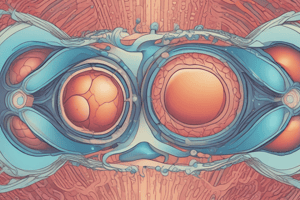Podcast
Questions and Answers
What triggers oocyte maturation in females?
What triggers oocyte maturation in females?
- Estrogen
- Luteinizing hormone
- Progesterone
- Follicle stimulating hormone (correct)
What is the result of meiosis I in males?
What is the result of meiosis I in males?
- Production of secondary spermatocytes
- Transformation of spermatogonia into primary spermatocytes (correct)
- Formation of four haploid sperms
- Reduction of chromosome number by half
What process involves the fusion of sperm and egg to create a unique offspring?
What process involves the fusion of sperm and egg to create a unique offspring?
- Gametogenesis
- Meiosis
- Fertilization (correct)
- Implantation
Where does the blastocyst attach itself during the implantation process?
Where does the blastocyst attach itself during the implantation process?
What is the end result of secondary spermatocytes splitting in males?
What is the end result of secondary spermatocytes splitting in males?
Where does Spermatogenesis occur?
Where does Spermatogenesis occur?
What is the name given to the newly formed fetal organism?
What is the name given to the newly formed fetal organism?
What is the function of the uterus during human development?
What is the function of the uterus during human development?
At approximately how many days post-conception does the inner mass of the blastocyst become visible?
At approximately how many days post-conception does the inner mass of the blastocyst become visible?
What structure forms from a zygote after several mitotic divisions?
What structure forms from a zygote after several mitotic divisions?
Flashcards are hidden until you start studying
Study Notes
Human Embryology is the scientific study of human development from conception through birth. It includes understanding how sperm cells meet egg cells, leading to new life. This article will focus on three key aspects of this fascinating field: Fertilization Process, Implantation in the Uterus, and Gametogenesis.
The Fertilization Process begins with Spermatogenesis, which happens in the testes of males. Here, sperm cells form from special types of stem cells called spermatozoa. When the male ejaculates into the female reproductive system during sexual intercourse, these sperm swim towards a fallopian tube where they meet an Egg cell released by the woman's ovary. When the two join together, their nuclei fuse to create one single nucleus containing all genetic information necessary for survival and growth.
Once inside the female, the Zygote (the name given to the newly formed fetal organism) travels down the Fallopian Tube until it reaches the Uterus, which serves as its home for nine months. In the early stages after conception, the zygote undergoes several mitotic divisions, eventually forming a Blastocyst - a hollow ball full of undifferentiated cells that can grow into many different tissues. At around seven days postconception, the inner mass of the blastocyst becomes visible due to a chemical reaction between proteins found within the egg white and those produced by the embryo itself. Eventually, the blastocyst attaches itself firmly onto the lining of the uterine wall via a process known as implantation.
Gametogenesis refers specifically to the production of eggs and sperm in both sexes respectively. For females, follicle stimulating hormone triggers oocyte maturation, causing them to develop further into mature gametes ready for release quickly upon ovulation. As mentioned earlier, in males spermatogonia transform into primary spermatocytes following meiosis I, which reduces the diploid chromosome number to half before meiosis II occurs. Once this is complete, secondary spermatocytes split again producing four haploid sperms - each carrying only one set of chromosomes required for reproduction.
In summary, Human Embryology involves studying the processes involved in creating a unique offspring from sperm and egg fusion, followed by implantation in the uterus and eventual growth as well as providing details on gamete formation. Understanding these basic principles helps us appreciate what makes humans so distinct among other living beings while also helping with reproductive medicine and assisted reproduction techniques.
Studying That Suits You
Use AI to generate personalized quizzes and flashcards to suit your learning preferences.




